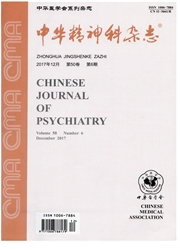

 中文摘要:
中文摘要:
目的 分析精神专科医院就诊的抑郁障碍和双相Ⅱ型抑郁患者精神障碍共病状况及其对抑郁发作类型的影响.方法 采用MINI中文版对符合美国精神障碍诊断与统计手册第4版修订版中抑郁障碍或双相Ⅱ型抑郁诊断标准的患者共病情况进行评估和比较,使用二分类Logisitc回归分析共病对抑郁发作类型的影响.结果 共入组833例患者,其中708例为抑郁障碍患者(抑郁障碍组),125例为双相Ⅱ型抑郁患者(双相Ⅱ型抑郁组).双相Ⅱ型抑郁和抑郁障碍的精神障碍共病比例分别为68.0%(70/125)和53.1%(277/708),差异有统计学意义(x2=9.534,P=0.002).前者共病场所恐惧症(无惊恐发作史)[26.4%(33/125)与8.1%(57/708),x2=31.118,P=0.000]、社交焦虑障碍[21.6%(27/125)与11.4%(81/708),x2=9.718,P=0.002]、精神病性症状[11.2% (14/125)与2.4% (17/708),x2=22.957,P=0.000]和进食障碍[3.2%(4/125)与0.7%(5/708),P=0.033]的构成比例显著高于后者.共病场所恐惧症(OR=3.332,95% CI 1.970~ 5.635,P=0.000)或精神病性症状(OR=3.432,95% CI 1.543~7.632,P=0.002),复发性抑郁(OR=2.457,95% CI 1.625~ 3.714,P=0.000)及自杀未遂史(OR=1.764,95%CI1.045~ 2.975,P=0.033)是双相Ⅱ型抑郁的影响因素.结论 抑郁障碍和双相Ⅱ型抑郁的精神障碍共病均较常见,对共病的全面评估及共病模式差异的识别或有助于抑郁发作类型的鉴别.
 英文摘要:
英文摘要:
Objective This report aimed at exploring magnitude of psychiatric comorbidities of patients with major depressive disorder (MDD) or bipolar Ⅱ depression.Comorbidity patterns between MDD and bipolar Ⅱ depression were compared and the association of clinical presentation with the two types of depressive episodes were analyzed.Methods A cross-sectional survey was conducted on a total of 833 patients that met the Diagnostic and Statistical Manual of Mental Disorders,Fourth Edition Text Revision criteria for MDD or bipolar Ⅱ depression with current major depressive episodes who were seeking help in a psychiatric hospital were enrolled.Endorsement of comorbid psychiatric disorders were based on the MINI-International Neuropsychiatric Interview (Chinese version).Psychiatric comorbidities were compared between the two groups and the binary logistic model was developed to estimate association of endorsement of psychiatric comorbidities with the two types of depressive episodes.Results Up to 68.0% (70/125) of participants with bipolar Ⅱ depression and 53.1% (277/708) of participants with MDD adopted at least one psychiatric comorbidity (x2=9.534,P=0.002).Significant difference of presence of agoraphobia (without panic attack) (26.4% (33/125) vs.8.1% (57/708),x2=31.118,P=0.000),social anxiety disorder (21.6% (27/125) vs.11.4% (81/708),x2=9.718,P=0.002),psychosis (11.2% (14/125) vs.2.4% (17/708),x2=22.957,P=0.000) and eating disorders (3.2% (4/125)vs.0.7% (5/708),P=0.033) were detected between the two groups.Comorbid agoraphobia (OR=3.332,95% CI 1.970-5.635,P=0.000) or psychosis (OR=3.432,95% CI 1.543-7.632,P=0.002),and endorsement of recurrent depression (OR=2.457,95% CI 1.625-3.714,P=0.000) or attempted suicides (OR=1.764,95% CI 1.045-2.975,P=0.033) was associated with bipolar Ⅱ depression.Conclusions MDD and bipolar Ⅱ depression differed in comorbidity patterns although psychiatric comorbidities are both commonly seen in th
 同期刊论文项目
同期刊论文项目
 同项目期刊论文
同项目期刊论文
 A study of N-methyl-D-aspartate receptor gene (GRIN2B) variants as predictors of treatment-resistant
A study of N-methyl-D-aspartate receptor gene (GRIN2B) variants as predictors of treatment-resistant Guidelines concordance of maintenance treatment in euthymic patients with bipolar disorder: Data fro
Guidelines concordance of maintenance treatment in euthymic patients with bipolar disorder: Data fro Difference in remission in a Chinese population with anxious versus nonanxious treatment-resistant d
Difference in remission in a Chinese population with anxious versus nonanxious treatment-resistant d Association between brain-derived neurotrophic factor genetic polymorphism Val66Met and susceptibili
Association between brain-derived neurotrophic factor genetic polymorphism Val66Met and susceptibili Atypical features and treatment choices in bipolar disorders: a result of the National Bipolar Mania
Atypical features and treatment choices in bipolar disorders: a result of the National Bipolar Mania Validation of the Chinese Version of the Short TEMPS-A and its application in patients with mood dis
Validation of the Chinese Version of the Short TEMPS-A and its application in patients with mood dis IL-23 and TGF-beta1 levels as potential predictive biomarkers in treatment of bipolar I disorder wit
IL-23 and TGF-beta1 levels as potential predictive biomarkers in treatment of bipolar I disorder wit 期刊信息
期刊信息
